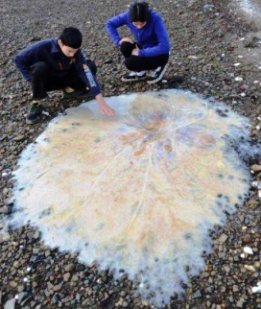 Gli scienziati sono all’opera per tentare di classificare la enorme medusa trovata sulla spiaggia di Hobart in Tasmania .
Gli scienziati sono all’opera per tentare di classificare la enorme medusa trovata sulla spiaggia di Hobart in Tasmania .
Questa nuova specie di medusa gigante, dal diametro di un metro e mezzo, si è arenata sul bagnasciuga
E’ lì è stata rinvenuta da una famiglia che passeggiava sulla spiaggia.
Secondo la biologa specializzata in meduse Lisa-ann Gershwin, dell'ente nazionale di ricerca Csiro, l'esemplare trovato è apparentato alla medusa a criniera di leone, una specie che può raggiungere i due metri.
La specie è stata vista prima, ma tecnicamente non è stata classificata.
"E' quindi nuova alla scienza ma presto avrà un nome", ha detto Gershwin alla radio australiana Abc.
Il ritrovamento "è una delle cose che veramente ci fa venire faccia a faccia con il fatto che vi sono cose che non conosciamo, in natura e particolarmente negli oceani", ha aggiunto. (ANSA)
La scienziata ha aggiunto che gli scienziati stano osservando nelle ultime settimane un proliferare di enormi meduse nelle acque della Tasmania.(Agi)
La notizia dal sito australiano:
Mysterious giant jellyfish found by family on Tasmanian beach, yet to be named
CSIRO scientists are working to classify a new species of giant jellyfish after one washed up on a beach in southern Tasmania.
The 1.5 metre jellyfish was found by a family walking on a beach at Howden, south of Hobart, last month.
There have been several reported in waters off the state and the research body has also captured specimens.
CSIRO scientist Lisa-ann Gershwin told ABC Local Radio while the species has been seen before, it is technically unclassified and new to science.
"It's a whopper. We do get large jellyfish and this one just happened to be this absolutely enormous specimen," she said.
"I do hear from time to time people tell me 'we found this one that was really big', but this one really is, really big.
"[We] finally got specimens this year of it, so it's new to science, but it's not a brand new thing completely out of left field.
"It's one of these things that really makes us come face-to-face with the fact that there are things we don't know about out there in nature, particularly in the ocean."
"I love that is was found by kids that they stumbled upon on this thing."
Twelve-year-old Xavier Lim was with his family when it was spotted.
"We were at the beach looking for shells and dad was like 'Whoa! Look at that'...I kind of touched it.. it was pretty cool," he said.
Dr Gershwin has been working on jellyfish for 20 years and says it is probably the biggest the state's ever seen, and could rival interstate finds.
"Generally the jellyfish tend to be bigger in the temperate regions rather than in the tropics, so certainly tropical jellyfish would tend to be smaller."
"I've been in Tassie working with jellyfish for a long time here and I've seen a lot of big jellyfish but this one's really big."
The jellyfish is not dangerous, but can sting.
"If you touched it or whacked into when you were swimming it is very painful," Dr Gershwin said.
"It's not life-threatening, but it will sting you, it will wake you up."
Ice can be used to relieve pain from stings.
Dr Gershwin says she has chosen a name for the species and is working to have it classified.








